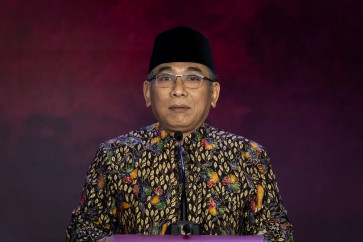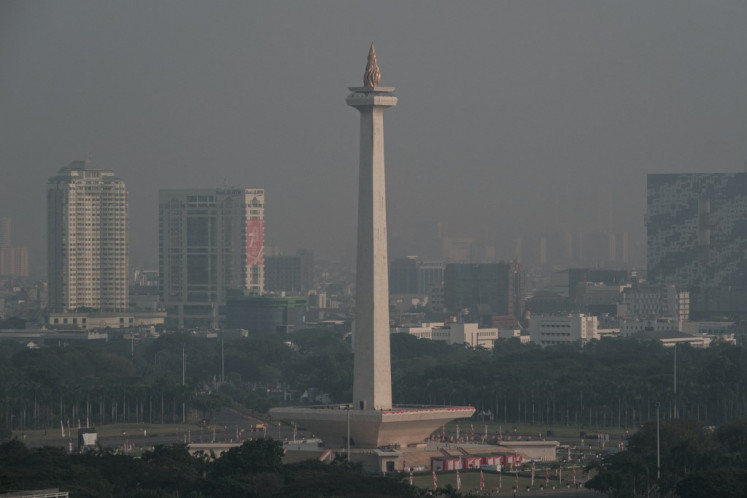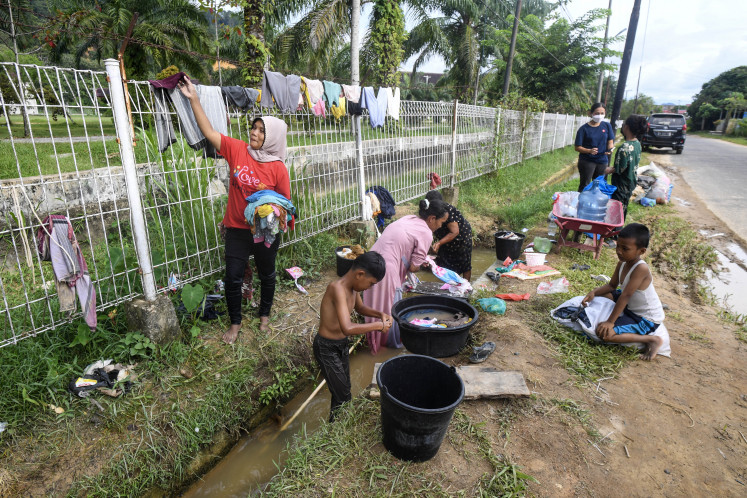Popular Reads
Top Results
Can't find what you're looking for?
View all search resultsPopular Reads
Top Results
Can't find what you're looking for?
View all search resultsReimagining Jakarta: A more compact life
Jakarta clearly has a dream
Change text size
Gift Premium Articles
to Anyone
J
akarta clearly has a dream. From the recent closure of the notorious Kalijodo red-light district, which is to be replaced by green spaces, to the building of the Semanggi project, the heart of the city of 10.2 million people is being renewed.
Earlier this year, the Jakarta chapter of the Indonesian Architects Association (IAI Jakarta) started a conversation on public space, housing and a reconception of the city. Governor Basuki “Ahok” Tjahaja Purnama opened the construction of an elevated road at the Semanggi interchange at a cost of US$27.15 million.
By next year, it is hoped that this new road will ease traffic in the business district.
Yet rebuilding Jakarta is not just a matter of technical engineering skills, or even policy commitment. Rather, it requires a thorough re-imagining of building elements of liveability into a compact, dense space.
A McKinsey report in 2011 stated that “The 21st century will not be dominated by America or China, Brazil or India, but by The City.”
Cities are fast becoming the nexus of economic, political and social power, predicted to host 70 percent of the world’s population by 2050.
Jakarta, among other developing cities, like Shanghai and Mumbai, falls into the high-density and low-liveability category.
With a density of 15,000 people per square kilometer, it secured a low 142 out of 221 cities in Mercer’s Quality of Life Index 2016.
As Indonesia’s economic engine and political capital, how will Jakarta follow its urbanization trajectory without compromising on quality of life? A city can either grow inward with a sprawl, or outward — with increasing density. From 2005 to 2030, developed and developing cities have tripled their land area.
There are deep social deficits and economic costs associated with such a living style.
We make the radical case that growing inward — with a denser, more compact lifestyle — is the way ahead. Contrary to bad density, characterized by un-liveability and environmentally damaging practices, good density is the ability to live affordably and in line with the planet’s resources. As cities such as London and
Singapore have shown, high density can go hand-in-hand with high liveability. Mixed-use projects, which combine residential, commercial and green spaces, stand out as essential in achieving good density.
By interweaving multiple uses of land for different income groups, these projects allow greater neighborhood variety and compact development.
The second ingredient to a highly liveable and dense city is an accessible and affordable transportation system, to reduce travel time and attract foreign investors.
Today, Jakarta’s roads are heavily congested and polluted. Overburdened roads cause a range of negative externalities, spanning from mere discomfort to pedestrian safety. In 2014, 806 of the 5,427 road accidents involved pedestrians, causing 65 deaths and 431 critical injuries. Inadequate pavements and the lamentable quality of existing ones, coupled with the authorities’ lack of concern for pedestrian well-being are the root of the issue.
But there are encouraging signs. Recent developments in Jakarta, such as Go-Jek (a mobile application to hitch rides with freelance motorcyclists), and community-led programs to raise awareness about pedestrian safety, suggest public eagerness to improve the city.
Aside from good-density principles and efficient transportation systems, cities have absorbed innovation at the heart of their growth.
For most cities, this means embodying high-tech digital infrastructure for integrated asset management and improved efficiency.
For instance, Yokkaichi in Japan transformed itself from the world’s most polluted city to a completely smart, recycling-friendly city.
Earlier this year, the Jakarta administration expressed its interest in making the city smarter. Governor Ahok announced a Smart City Program, encompassing public transportation applications, electronic libraries and more.
Good density involves creating open spaces for the community to congregate at. Parks, riverine trails, libraries, museums and football fields allow all citizens, irrespective of their status and payroll, to interact with one another and immerse themselves in cultural and recreational activities. By absorbing the philosophy of equality of life in the heart of urban fabric, compact urban design avoids exclusion and serves more people.
Ultimately, it is the happiness of the people that marks the success of a city. In ancient Greece, eudaimonia or being healthy, happy and prosperous was man’s ultimate goal.
Not only do urban spaces play a large role in deciding our happiness, they also influence the paths we take to achieve it.
By focusing on good density, mobility, innovation and happiness, Jakarta can achieve both high liveability and high density.
__________________________________
The writer works on urban water research at the Institute of Water Policy, Lee Kuan Yew School of Public Policy, National University of Singapore.










